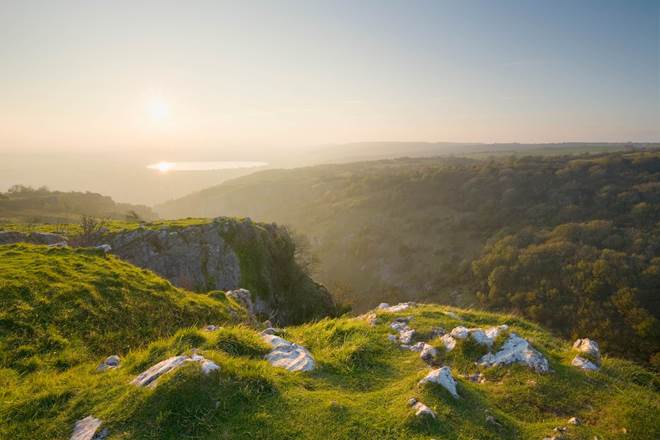Itching to swap your couch for a little adventure in Tolkien’s universe, huh?
Forget New Zealand for a minute — yes, it’s gorgeous, but did you know that the rolling hills and rustic mills of good ol’ England were the real springboards for Middle-earth?
That’s right, long before this legendarium became synonymous with New Zealand, J.R.R. Tolkien was gazing out at the English countryside, brewing up hobbits and ringwraiths.
Let’s uncover the charming and sometimes cheeky British spots that tickled Tolkien’s fancy!
Image Credit: Getty Images, James Osmond. Image Location: Malvern Hills, England
Exploring Tolkien’s inspirations in England, UK
The Malvern Hills → The White Mountains
Strap on your hiking boots and trek through The Malvern Hills. These aren’t just any old hills; they could easily double as the White Mountains guarding the approaches to Rohan. Tolkien and C.S. Lewis stomped around here, likely debating whether Orcs prefer their man-flesh medium rare or well-done. With every step, you might just feel the urge to shield your eyes from the glaring White City of Gondor in the distance.
Closest train stations: Great Malvern, Worcestershire
Sarehole Mill → Hobbiton
Ever wonder where Hobbits get their rustic charm? Look no further than Sarehole Mill. Nestled in the outskirts of Birmingham, this quaint old mill could very well be the model for the Shire’s own watermill. Young Tolkien used to play around here, probably dodging imaginary Black Riders rather than schoolwork. It’s the kind of place where you half-expect to see Frodo Baggins pop out for a quick gossip.
Closest train stations: Hall Green, Birmingham
Moseley Bog → The Old Forest
Tread lightly through Moseley Bog; you never know when a tree might just decide to pick up its roots and relocate. Reminiscent of the eerie Old Forest, where trees have a penchant for silence and creeping, this bog could very well have given Tom Bombadil a run for his money. It’s a spooky, moss-covered wonder perfect for plotting an unexpected journey or two.
Closest train stations: Hall Green, Birmingham New Street
University of Birmingham’s Great Hall → The Hall of Elrond
Pop into the University of Birmingham’s Great Hall and you might just expect to catch an elf munching on lembas bread. While there's no direct scroll or tome where Tolkien says, “This hall is Elrond’s home,” the grandeur and high ceilings surely make it easy to imagine it as such. It’s the kind of place where you could debate the finer points of Elvish script or just marvel at the mystical vibe that feels right out of Rivendell.
Closest train stations: University (Birmingham), Birmingham New Street
Image Credit: Getty Images, LanceB. Image Location: Warwick Castle, England
Warwick Castle → Helm’s Deep
Next stop, Warwick Castle, which might as well be a stand-in for Helm’s Deep with its towering battlements and dark history of sieges. Tolkien never officially penned down Warwick as the blueprint for Helm’s Deep, but let’s just say if he needed a castle for a last stand, this would fit the bill. It’s perfect for envisioning epic battles or simply enjoying a peaceful afternoon tea—minus the Uruk-hai.
Closest train station: Warwick
Cheddar Gorge → Helm’s Deep
Another contender for Helm’s Deep, Cheddar Gorge boasts dramatic cliffs and dark, echoing caves just begging for a showdown with Saruman’s army. It’s the sort of rugged landscape where you feel compelled to shout heroic commands into the wind, or at least complain loudly about the lack of elevators to the top.
Closest train stations: Yatton, Somerset
Lyme Park, Cheshire → Gondor
Lyme Park is so stately it might as well have been airlifted straight from Gondor. With its grand estates and sweeping views, you can almost spot the White Tree and the throne of the king.
Closest train stations: Disley, Cheshire
Oxford’s Bodleian Library → Minas Tirith’s Archives
For a touch of Minas Tirith right in the heart of England, head over to Oxford’s Bodleian Library. While Tolkien himself didn’t point out this library as a direct inspiration, its towering stacks and ancient tomes are just the type of place where Gandalf would’ve spent hours researching Ring lore. The awe-inspiring architecture and historic ambiance could easily double for the storied archives of the White City.
Closest train station: Oxford
Image Credit: Getty Images, James Warwick. Image Location: Ashsown Forest, England
Ashdown Forest → Mirkwood
If you fancy a stroll through a forest steeped in silence and shadow, Ashdown Forest in East Sussex is your go-to. This ancient woodland, with its dense thickets and whispering breezes, channels the eerie essence of Mirkwood. Just keep an eye out for spiders larger than your hand—or at least be prepared to duck under some gnarly branches.
Closest train stations: East Grinstead, West Sussex
Northmoor Road, Oxford → Bag End
While not a grand landscape or ancient building, the quaint and leafy Northmoor Road in Oxford, where Tolkien once lived, might just give you a glimpse into the day-to-day of a hobbit. The peaceful neighborhood with its charming gardens and cozy homes whispers hints of Bag End’s serene domesticity.
Closest train station: Oxford
J.R.R. Tolkien’s Middle Earth: need to know
First of all, is it “Tolkien” or “Tolkein”?
The correct spelling is “Tolkien”. Keep it keen: in his name, “i” before “e” is the scene!
What is the Tolkein Gateway?
Whoops-a-daisy! It’s an easy mix-up, so let’s clear this up again: it’s spelled “Tolkien”. The Tolkien Gateway isn’t a magical portal to Middle-earth (though that would be awesome!), but it’s the next best thing! It’s an extensive online encyclopedia that’s all about Tolkien’s works and everything in the vast universe he created. If you’re itching for details about hobbits, orcs, or even the less sung-about Swan Knights of Dol Amroth, that’s your go-to resource.
Where did Tolkien get his inspiration for Middle-earth?
J.R.R. Tolkien found his muse in the landscapes and lore of his surroundings. From the pastoral bliss of Sarehole Mill reminiscent of the Shire to the towering Malvern Hills that echo the White Mountains, England’s geography deeply influenced the vivid settings of Middle-earth. Tolkien’s academic background in languages and mythology also played a crucial role in shaping his legendary world.
Image Credit: Getty Images, James Osmond. Image Location: Cheddar Gorge, Somerset, England
How did Tolkien’s environment influence his depiction of Middle-earth?
Tolkien’s personal experiences and the natural beauty of England were mirrored in the peaceful valleys, ominous forests, and ancient structures of Middle-earth. Places like the enchanting University of Birmingham’s Great Hall and the imposing Warwick Castle can be seen as real-world echoes of the Elven halls and fortified cities described in his tales.
Can you tell me more about Tolkien’s inspiration for Middle-earth?
Beyond the rolling English landscapes, Tolkien’s inspiration for Middle-earth was also derived from his profound knowledge of classical and northern European mythologies. His academic life, wartime experiences, and a rich tapestry of literature ranging from Beowulf to the Finnish Kalevala fed into the creation of a world that feels both timeless and deeply rooted in storytelling traditions.
Ready to embark on your own epic quest through Tolkien’s England? Don’t forget to download the Trainline app to easily hop from one legendary locale to the next. With just a few taps, you can plot your journey from the Shire-esque charms of Sarehole Mill to the dramatic cliffs of Cheddar Gorge.
The Road goes ever on and on, down from the door where it began!
Header Image Credit: Getty Images, James Osmond. Image Location: Cheddar Gorge, Somerset, England


